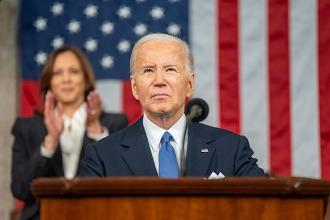U.S. equity markets saw sharp declines Friday, but closed just off session lows, as oil prices resumed a recent rout and nervousness about China flared again.
The Dow Jones Industrial Average dropped 391 points, or 2.39% to 1587. The S&P 500 plunged 41 points, or 2.16% to 1880, while the Nasdaq Composite shed 126 points, or 2.74% to 4488.
The energy sector plunged around 4%, followed by financials and consumer discretionary, which led the session’s losses.
Today's Markets
It was a week of extreme seesawing in the markets, and Wall Street looked to end the five-day period on a sour note just one session after posting the biggest gains of the year, on the heels of the sharpest one-day loss of 2016.
“We continue to be knocked around by overseas. The pattern is painfully familiar,” Paul Christopher, managing director and head global market strategist at Wells Fargo Investment Institute said. “China does something or has some new political announcement, equities selloff further there. As that happens, it raises the specter of worry about a China slowdown accelerating, which spills into equities, and commodities around the world. Deflation fears come out of that and by the time we wake up, everything’s primed for a selloff. It’s a series of policy misunderstandings and uncertainty of growth.”
After two days of gains in the oil patch, global crude prices resumed their downward trend, falling below the psychologically-significant $30 a barrel. West Texas Intermediate crude prices dipped as low as $29.13, the lowest level since November 2003.
In recent action, WTI plunged 5.7% to settle at $29.42 a barrel, while Brent, the international benchmark, dropped 5.9% to $29.05 a barrel.
Renewed pressure in oil comes amid fresh concerns about China's markets and economy as the benchmark Shanghai Composite entered bear-market territory on Friday for the second time in six months.
Potential for Iranian oil to flood the already-saturated oil market is also weighing on the minds of commodities traders.
The energy sector, which saw gains of 4.62% during Thursday's session, tumbled well more than 3% on Friday as majors Chevron (CVX) and Exxon (XOM) weighed heavily on the Dow Industrials.
Christopher said right now, energy is not the place to look for investment opportunities.
“We strongly advise against it,” he said. “Supply [excess] is aggravated by fears that the economy is going to slow. Industrial production data reinforced that idea. The funny thing is that the longer prices stay below $40 a barrel, the more exaggerated the supply response will be. Supply is growing less than demand.”
Corporate earnings season, which investors looked to for signs of life in the global-market picture, looked to be a bright spot. But with so much negative sentiment flooding the market, mostly better-than-expected results from two of the nation’s biggest banks couldn’t inject any positive momentum.
Results from aluminum maker Alcoa (AA) earlier in the week, and JPMorgan Chase (JPM) helped extend a feeling of confidence in the stability of corporate America on Thursday, but it wasn’t enough to sustain momentum Friday.
Financial houses Citigroup (C) and Wells Fargo (WFC) took the wraps off their 4Q results on the last trading day of the week ahead of the bell.
Citi revealed a beat on both lines during the quarter, posting earnings per share excluding credit and debt valuation adjustments of $1.06, on revenue on $18.64B, topping expectations for earnings per share of $1.05 on revenue of $17.87 billion.
Wells Fargo posted mixed results: The nation’s fourth-largest bank by assets revealed adjusted profits per share of $1.03, topping views by a penny. Revenue of $21.6 billion, however, missed expectations for $21.8 billion.
Christopher warned, though, don’t expect a sharp rebound rally solely on fourth-quarter earnings season. There’s still a slew of factors that are likely to impact the market more broadly.
“I think in terms of the market being forward looking, the fourth quarter will matter insofar as forward guidance from companies. Even with that, though, we have to get through the worst of the winter, so they’ll be heavy discounting around guidance since we have a lot of 1Q to go through,” he explained.
A slew of economic data didn’t do much to help the market. Retail sales failed to excite the street when the Commerce Department reported sales dipped 0.1% last month, compared to unchanged expectations. Excluding the volatile auto component, sales still slipped 0.1%, an unexpected decline compared to forecasts for a 0.2% rise.
Investors had hoped to see signs in the figures that consumers were willing to spend cash saved at the pump thanks to the low oil prices of the last year and a half.
It wasn’t all doom and gloom for the consumer, though, a January reading on the University of Michigan’s consumer sentiment gauge rose to 93.3 from a final December reading of 92.6. Wall Street expected 93.
Also out was data from the Labor Department on wholesale-level inflation, which slid 0.2% last month, matching expectations. After stripping out the food and energy components, prices rose 0.1%, also matching views.
Another month, another round of contraction for Empire State manufacturing activity. The New York Federal Reserve reported its gauge of factory activity dropped to -19.37 in January, the lowest level since March 2009. The reading was down from a revised -6.21 the month prior, while Wall Street had anticipated a reading of -4. Readings above 0 point to expansion, while those below indicate contraction.
As traders hit the equity-market exits, they flocked to safe havens like Treasury bonds and gold. The precious metal jumped 1.56% in recent action to $1,090 a troy ounce. The yield on the 10-year U.S. Treasury bond, meanwhile, dropped below 2%. In recent action, it shed 0.075 percentage point to 2.02%. Yields move in the opposite direction of prices.















